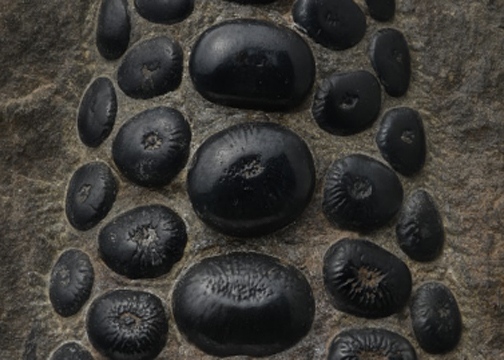Abstract
The Pycnodontiformes is a distinctive group of fossil actinopterygian (ray-finned) fishes from the Late Triassic to Palaeogene. Tibetodus gyrodoides, reported in 1954, represents the only known fossil record of this group in China, holding significant scientific and historical importance. In this study, non-destructive techniques such as scanning electron microscopy (SEM) and micro-computed tomography (micro-CT) were utilised to reexamine the specimen, providing new insights into both the surface morphology and internal structures of the vomer and its teeth and investigating the process of tooth wear. A tooth covered by matrix was also discovered. Furthermore, an Elliptical Fourier Analysis (EFA) was conducted to quantitatively analyse the morphology of the palatal teeth in this specimen, adding new data for future research on pycnodontiforms and their feeding behavior.
References
- Bonhomme, V., Picq, S., Gaucherel, C. & Claude, J. (2014) Momocs: outline analysis using R. Journal of Statistical Software, 56, 1–24. https://doi.org/10.18637/jss.v056.i13
- Cawley, J.J., Marramà, G., Carnevale, G., Villafaña, J.A., López‐Romero, F.A. and Kriwet, J., (2021) Rise and fall of †Pycnodontiformes: Diversity, competition and extinction of a successful fish clade. Ecology and Evolution, 11 (4), 1769–1796. https://doi.org/10.1002/ece3.7168
- Cavin, L., Garcia, G. & Valentin, X. (2020) A minute freshwater pycnodont fish from the Late Cretaceous of southern France: Palaeoecological implications. Cretaceous Research, 106, 04242. https://doi.org/10.1016/j.cretres.2019.104242
- Chang, M.M. & Miao, D.S. (2004) An overview of Mesozoic fishes in Asia. In: Arratia, G. & Tintori, A. (Eds), Mesozoic Fishes 3 - Systematics, Paleoenvironments and Biodiversity. Verlag Dr. Friedrich Pfeil, Munich, 535–563.
- Sally, C.J. (2021) Unique damage-related, gap-filling tooth replacement in pycnodont fishes. Palaeontology, 64 (4), 489–504. https://doi.org/10.1111/pala.12539
- Deakin, W.J., Anderson, P.S., den Boer, W., Smith, T.J., Hill, J.J., Rücklin, M., Donoghue, P.C. & Rayfield, E.J. (2022) Increasing morphological disparity and decreasing optimality for jaw speed and strength during the radiation of jawed vertebrates. Science Advances, 8 (11), eabl3644. https://doi.org/10.1126/sciadv.abl3644
- Fischer, V., Bennion, R.F., Foffa, D., MacLaren, J.A., McCurry, M.R., Melstrom, K.M. & Bardet, N. (2022) Ecological signal in the size and shape of marine amniote teeth. Proceedings of the Royal Society B, 289, 20221214. https://doi.org/10.1098/rspb.2022.1214
- Ihaka, R. & Gentleman, R. (1996) R: a language for data analysis and graphics. Journal of computational and graphical statistics, 5 (3), 299–314. https://doi.org/10.1080/10618600.1996.10474713
- Kriwet, J., 2005. A comprehensive study of the skull and dentition of pycnodont fishes. Zitteliana, 45, 135–188.
- Li, P. (1955) Preliminary understanding about the geology of eastern Tibet. Chinese Science Bulletin, 6 (7): 62–71. [In Chinese] https://doi.org/10.1360/csb1955-0-7-62
- Longbottom, A.E. (1984) New Tertiary pycnodonts from the Tilemsi valley, Republic of Mali. Bulletin of the British Museum (Natural History), Geology, 38, 1–26.
- Matsui, K. & Kimura, Y. (2022) A “mammalian-like” pycnodont fish: Independent acquisition of thecodont implantation, true vertical replacement, and carnassial dentitions in carnivorous mammals and a peculiar group of pycnodont fish. Life, 12 (2), 250. https://doi.org/10.3390/life12020250
- Nursall, J.R. & Maisey, J.G. (1991) Neoproscinetes figueiredo and Silva Santos, 1987. In: Maisey, J.G. (Ed.), Santana Fossils. T.F.H. Publications, Inc., New York, 125–136.
- Poyato-Ariza, F.J. & Wenz, S. (2002) A new insight into pycnodontiform fishes. Geodiversitas, 24, 139–248.
- Poyato-Ariza, F.J. & Wenz, S. (2005) Akromystax tilmachiton gen. et sp. nov., a new pycnodontid fish from the Lebanese Late Cretaceous of Haqel and En Nammoura. Journal of Vertebrate Paleontology, 25, 27–45. https://doi.org/10.1671/0272-4634(2005)025[0027:ATGESN]2.0.CO;2
- Poyato-Ariza, F.J. (2015) Studies on pycnodont fishes (I): evaluation of their phylogenetic position among actinopterygians. Rivista Italiana di Paleontologia e Stratigrafia, 121 (3), 329–343.
- Poyato-Ariza, F.J. (2020) Studies on pycnodont fishes (II): Revision of the subfamily Pycnodontinae, with special reference to Italian forms. Rivista Italiana di Paleontologia e Stratigrafia, 126 (2), 447–473.
- Young, C.C. & Liu, H.T. (1954) Tibetodus, a new pycnodont fish from Changtu. Acta Palaeontologica Sinica, 2 (1), 95–102. [In Chinese with English summary]


